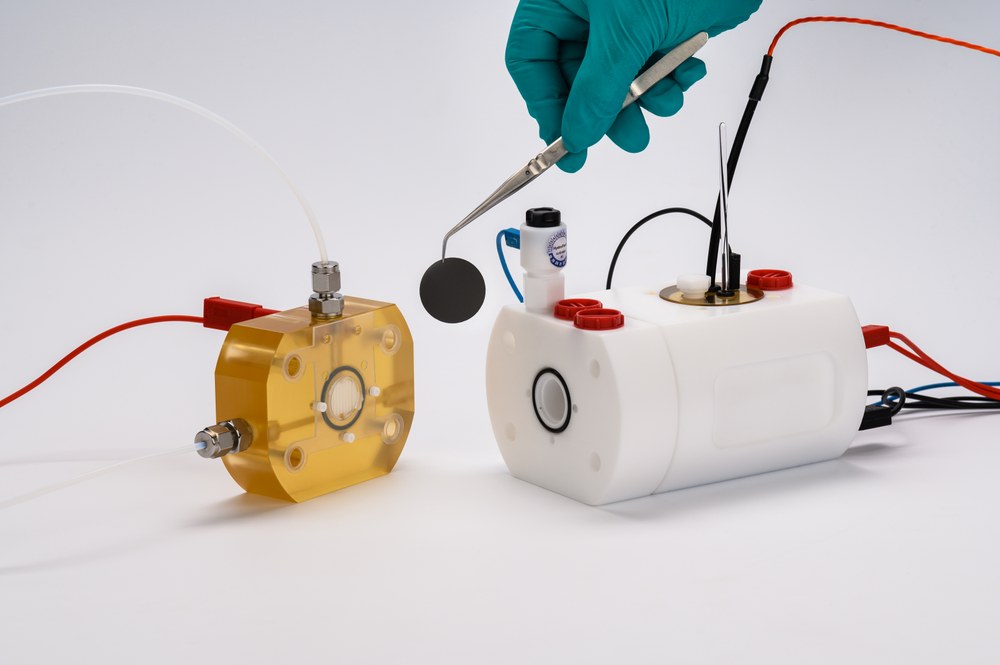SuNRed

In the SuNRed (Surface engineered metal Nitrides for genuine nitrogen Reduction) research project, researchers at the DLR Institute of Engineering Thermodynamics are investigating transition metal nitrides as electrocatalysts for electrochemical ammonia synthesis (EAS). The required nitrogen reduction reaction (NRR) is the limiting process, whereby nitrides are said to have energetic advantages due to the presumed Mars-van-Krevelen (MvK) mechanism. By using nitrogen vacancies in the MvK mechanism and optimising the coordination environment of these vacancies, the project aims to develop active catalysts for the NRR.
Electrochemical ammonia synthesis as an alternative to the large-scale Haber-Bosch process
Electrochemical ammonia synthesis (EAS) represents the direct synthesis of green ammonia through the use of nitrogen, water and renewable energies and can thus be a decentralised alternative to the large-scale Haber-Bosch process, which is a major emitter of greenhouse gases due to the process conditions. However, the activation of the stable nitrogen molecule (N2) is the limiting process and there is currently a lack of efficient electrocatalysts for the necessary nitrogen reduction reaction (NRR) in aqueous electrolytes. The low reaction rates and Faradaic efficiencies pose a major challenge in the identification of genuine active electrocatalysts and have led to many false-positive study results in research.
Transition metal nitrides, which catalyze NRR via the Mars-van-Krevelen (MvK) mechanism, are a promising material candidate. Here, nitrogen vacancies in the crystal lattice play a decisive role in the energetically favored activation of the nitrogen molecule. In the research project, these vacancies are to be used in a targeted manner and the concentration of vacancies and the coordination environment of the vacancies are to be controlled by optimizing the surface structure. The latter is achieved, for example, by introducing heteroatoms such as oxygen into the crystal structure. The research project is being carried out jointly with the working groups of Prof Anjana Devi from the Ruhr University in Bochum and Prof Michael Wark from the Carl von Ossietzky University in Oldenburg as well as with support from the team of Prof Michael Nolan from the Tyndall National Institute in Cork, Ireland
Trace analysis of ammonia by ion chromatography as the key to activity detection
The low reaction rates and Faradaic efficiencies prevent direct electrochemical activity determination and instead require the quantification of formed ammonia or ammonium in acidic electrolytes by analytical methods. Ion chromatography is used for this purpose at DLR and the methodology is being further developed to quantify ammonium in the trace range. This is an important step in the actual determination of genuine NRR activity.
Integration of research in the Priority Programme of the German Research Foundation
The SuNRed research project is part of the Priority Programme (SPP) 2370 "Nitroconversion" of the German Research Foundation (DFG). In this network of eleven projects, which is coordinated by the University of Bayreuth, research is being conducted into electrocatalytic, photocatalytic and photoelectrochemical processes for activating the nitrogen molecule and converting it into higher-value chemicals and fuels.

Project objectives
The work in the SuNRed project aims to develop active electrocatalysts for the nitrogen reduction reaction by optimising the surface structure of transition metal nitrides.
SuNRed at a glance
Project | Surface engineered metal Nitrides for genuine nitrogen Reduction (SuNRed) |
|---|---|
Duration |
|
Support | Priority Programme of the German Research Foundation (DFG), Project No. 502054395 |
